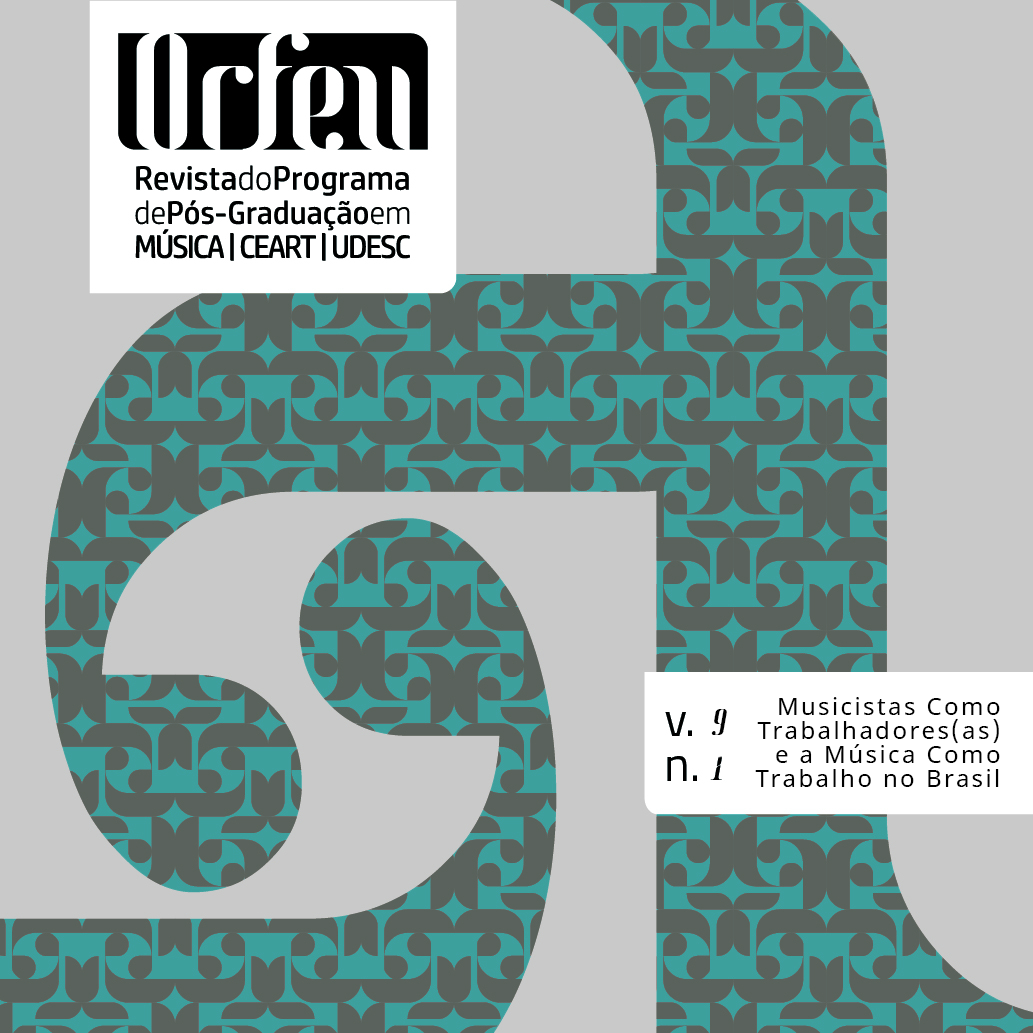Listening as an enunciative strategy
DOI:
https://doi.org/10.5965/2525530409012024e0207Keywords:
sound studies, listening, power relations, discourse analysisAbstract
This article proposes a critical analy-sis on the premises that embodies recent materialist ontological theories from the sound studies field. We selected the texts of Christoph Cox and Salomé Voegelin as objects of study. First, we presente some authors who investigate the sound and the listening through historical-social ele-ments. Subsequently, we analyzed the the-oretical discourses representative of Cox and Voegelin’s approaches. We compared the authors’ statements to an illustration of pieces and sound characteristics. In order to locate the limits and the problems of the approaches, we seek to understand them through foucauldian notions of discursive practice and enunciative modality.
Downloads
References
BONNET, François J. The order of sounds: a sonorous archipelago. 2° edição. MIT Press, 2019.
CAGE, John. Silence: Lecture and writings by John Cage. Middletown: Wesleyan University Press, 1973. 312p.
CASTRO, Edgardo. Vocabulário de Foucault: um percurso pelos seus temas, conceitos e autores. Belo Horizonte: Autêntica Editora, 2009.
COX, Christoph. Sound Art and the Sonic Unconscious. Organised Sound, v. 14, n. 1, p. 19-26, 2009. Disponível em: < https://faculty.hampshire.edu/ccox/Cox%20article%20OS%2014.1.pdf >. Acesso em: 31 de mar. de 2024.
____. Beyond representation and signification: toward a sonic materialism. Journal of visual culture, v. 10, n. 2, p. 145-161, 2011. Disponível em: <https://www.academia.edu/3757421/Beyond_Representation_and_Signification_Toward_a_Sonic_Materialism>. Acesso em: 31 de mar. de 2024.
____. Sonic flux: sound, art, and metaphysics. Chicago: The University of Chicago Press, 2018a.
____. Sonic Realism and Auditory Culture: a Reply to Marie Thompson and Annie Goh. Parallax, v. 24, n. 2, p. 234-242, 2018b. Disponível em: <https://faculty.hampshire.edu/ccox/Cox.Sonic%20Realism%20and%20Auditory%20Culture.pdf > Acesso em: 31 de mar. de 2024.
ERLMANN, V. Reason and resonance: a history of modern aurality. Nova Iorque: Zone Books, 2010.
FOUCAULT, Michel. A arqueologia do saber. 7° edição. Rio de Janeiro: Forense Universitária, 2005.
__________. A ordem do discurso. 24° Edição. São Paulo: Edições Loyola, 2014.
GOEHR, Lydia. The Imaginary Museum of Musical Works: An Essay in the Philosophy of music. Oxford: Clarendon Press, 1992.
HAINGE, Greg. Noise Matters: Towards an Ontology of Noise. Nova Iorque: Bloomsbury Publishing, 2013.
JOHNSON, James H. Listening in Paris: a cultural history. Los Angeles: University of California Press, 1995.
KAHN, Douglas. Sound art, art, music. The Iowa Review Web, v. 8, n. 1, p. 23-36, 2006.
KANE, Brian. Sound studies without auditory culture: a critique of the ontological turn. Sound Studies, v. 1, n. 1, p. 2-21, 2015.
_____. Musicophobia, or Sound Art and the Demands of Art Theory. Editorial Board. v. 8, p. 1-20, 2013. Disponível em: <https://www.academia.edu/11590182/Musicophobia_or_Sound_Art_and_the_Demands_of_Art_Theory> . Acesso em: 31 de mar. de 2024.
LABELLE, Brandon. Background Noise: perspectives on Sound Art. 2° Edição. Nova Iorque: Bloomsbury Publishing, 2015.
LICHT, Alan. Sound Art: Origins, development and ambiguities. Organised Sound, v. 14, n. 1, p. 3-10, 2009.
_____.Sound Art Revisited. Nova Iorque: Bloomsbury Publishing, 2019.
MILLS, Sara. Discourse. Londres e Nova Iorque: Routledge, 1997.
STERNE, Jonathan. The Audible Past: cultural origins of sound reproduction. Durham & London: Duke University Press, 2003.
SZENDY, Peter. Listen: a history of our ears. Nova Iorque: Fordham University Press, 2008.
THOMPSON, Marie. Whiteness and the Ontological Turn in Sound Studies. Parallax, v. 23, n. 3, p. 266-282, 2017.
VOEGELIN, Salomé. Listening to Noise and Silence: Towards a philosophy of sound art. New York: Continuum, 2010.
Downloads
Published
How to Cite
Issue
Section
License
Copyright (c) 2024 Daniel Gouvea Pizaia

This work is licensed under a Creative Commons Attribution 4.0 International License.
Authors who submit their manuscripts to be published in this journal agree to the following terms:
1. Authors retain the copyright and grant to the journal the right of first publication, whilst simultaneously permitting their work to be licensed under the Creative Commons License Attribution, which allows the sharing of work with recognition of the authorship and initial publication in this journal.
2. Contributions in this journal are open access; this means they are based in free use, and non-commercial applications.






